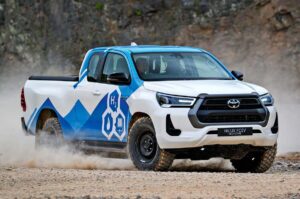Summary
- HMRC's tax reform in April 2025 shifts double-cab pick-ups to emissions-weighted BIK, impacting diesel models.
- The Isuzu D-Max EV targets company-car buyers with 0 g/km emissions and strong payload and towing capabilities.
HMRC’s switch to CO₂-based company tax from April 2025 has upended the UK double-cab market — pushing high-CO₂ diesel models into punitive Benefit-in-Kind (BIK) bands and creating a clear opening for electric pick-ups. Isuzu is targeting that gap with the D-Max EV, pitched at salary-sacrifice and company-car buyers thanks to 0 g/km emissions, competitive payload and strong towing ability.
What changed: the April 2025 tax reform in plain terms
- From 6 April 2025, most new double-cab pick-ups (four doors, two rows) are treated as passenger cars, not light commercial vehicles (LCVs).
- Companies now claim capital allowances capped by CO₂ emissions, and drivers are taxed under the emissions-weighted BIK system instead of the old flat LCV rate.
- The result: many diesel double-cabs — typically >200 g/km CO₂ — fall into the top BIK band (37%), sharply increasing the tax burden for drivers.
- Vehicles registered before 6 April 2025 can continue under the old LCV rules until 5 April 2029 or until resale.
Market effect: hit to diesel, boost for low-emission trucks
- The pre-deadline rush to register trucks produced a boom-and-bust pattern: volumes rose 19% year-on-year in Q1 then dropped 3% over the following six months (SMMT).
- CO₂-weighted BIK makes low-emission PHEVs and EVs much more attractive for fleets and salary-sacrifice schemes — and that’s where Isuzu sees its opportunity.
D-Max EV: how Isuzu is positioning the pick-up
Isuzu UK’s national sales manager Neil Scott says the D-Max EV “opens new doors” for lifestyle and company-car customers as the market pivots to electrification. Key claims from the model and Isuzu’s positioning:
- Emissions: 0 g/km CO₂ — qualifies for the lowest BIK band (3%).
- Payload: 1 tonne.
- Towing: 3.5 tonnes — stronger than some rival EV pick-ups such as the Maxus eT50/eTerron 9.
- Tax advantage: taxed at 3% of list price for BIK calculations (see quick example below).
- Target buyers: salary-sacrifice employees, company-car fleets and retail/lifestyle buyers who want 4×4 capability without the diesel tax penalty.
“Recent changes to benefit-in-kind and capital allowances have reshaped the double-cab pick-up market,” Neil Scott told Autocar. “The D-Max EV opens new doors for us… It’s an exciting new option as the market transitions towards EVs.”
Salary-sacrifice & BIK — why EV pick-ups suddenly make sense
- Salary-sacrifice schemes remain attractive for EVs: drivers pay low-rate BIK on the car benefit instead of being taxed on the full rental amount taken from gross pay.
- BIK threshold: the tax advantage flips at 75 g/km — a limit that excludes virtually all diesel double-cabs.
- Example calculation (illustrative): For a vehicle with a £60,000 list price taxed at 3% BIK, the taxable benefit = £1,800. At a 20% income tax rate, annual tax = £360 (~£30/month). By contrast, the same list price taxed at 37% (highest BIK band) would yield an annual tax of £4,440 (~£370/month). (These figures are examples to show the calculation method.)
Quick comparison: D-Max EV vs legacy diesel and PHEV alternatives
| Measure | D-Max EV | Typical diesel double-cab | Ford Ranger PHEV (example) |
|---|---|---|---|
| CO₂ emissions | 0 g/km | Typically >200 g/km | ~71 g/km (example) |
| BIK % (current rules) | 3% | 37% (top band) | Depends on g/km (higher than 3%) |
| Payload | 1,000 kg | Varies | Varies |
| Towing | 3.5 t | Varies | Varies |
| Salary-sacrifice eligibility | Yes (full benefit) | Excluded by high CO₂ | Partial, depends on CO₂ |
Isuzu’s strategy: volume, capability and rules compliance
Isuzu says it won’t chase “lifestyle-only” trims for the D-Max EV; instead the brand aims to:
- Serve business customers that demand payload and towing.
- Offer the 4×4 versatility retail buyers want.
- Put pick-ups at the centre of a zero-emission future while staying ahead of regulatory changes.
What this means for buyers and fleets
- Fleet managers: should re-evaluate double-cab replacements — diesel may now be far costlier on company car tax.
- Drivers on salary-sacrifice: could see significantly lower monthly tax bills with an EV double-cab.
- Retail buyers: electric pick-ups are increasingly viable for lifestyle use — especially where towing and payload are required.






GIPHY App Key not set. Please check settings